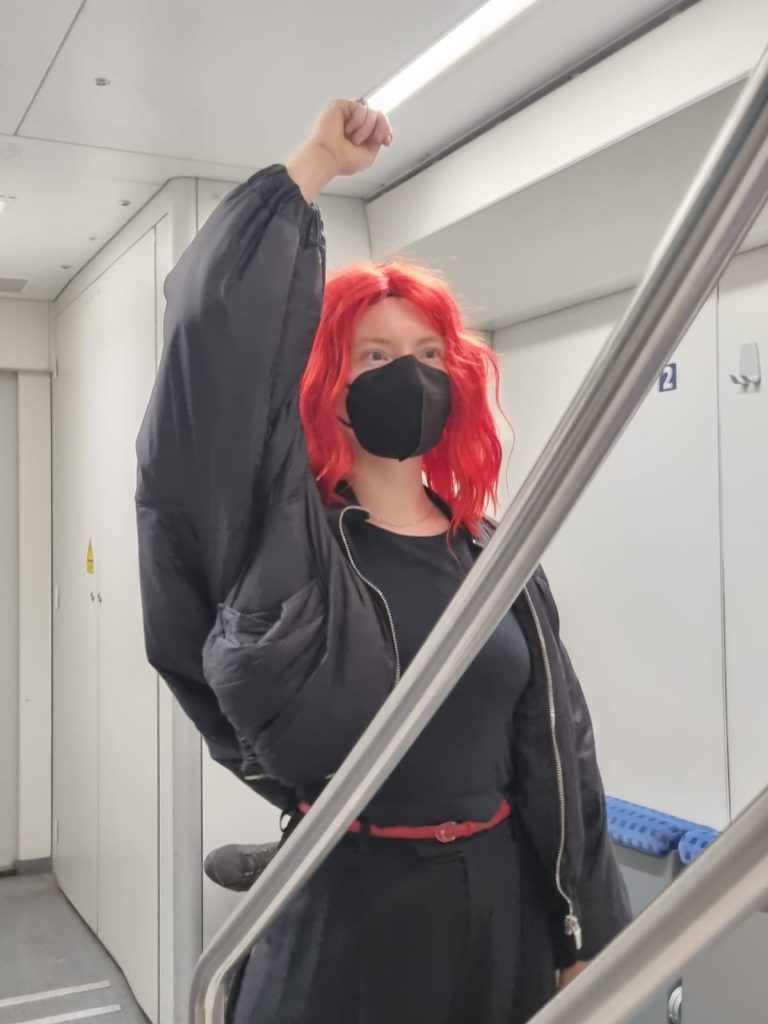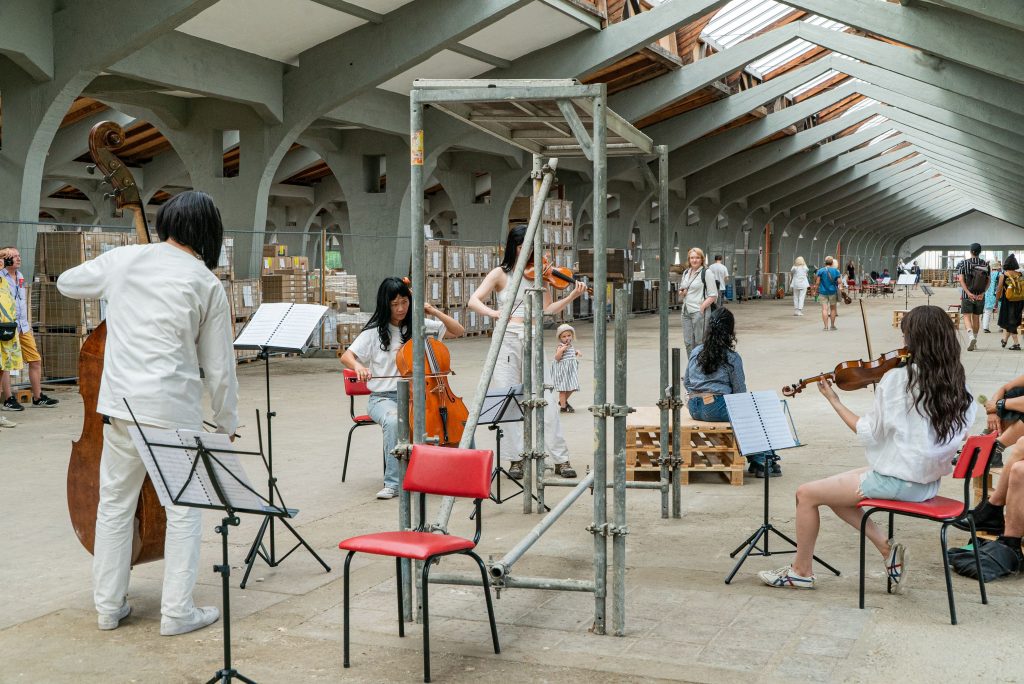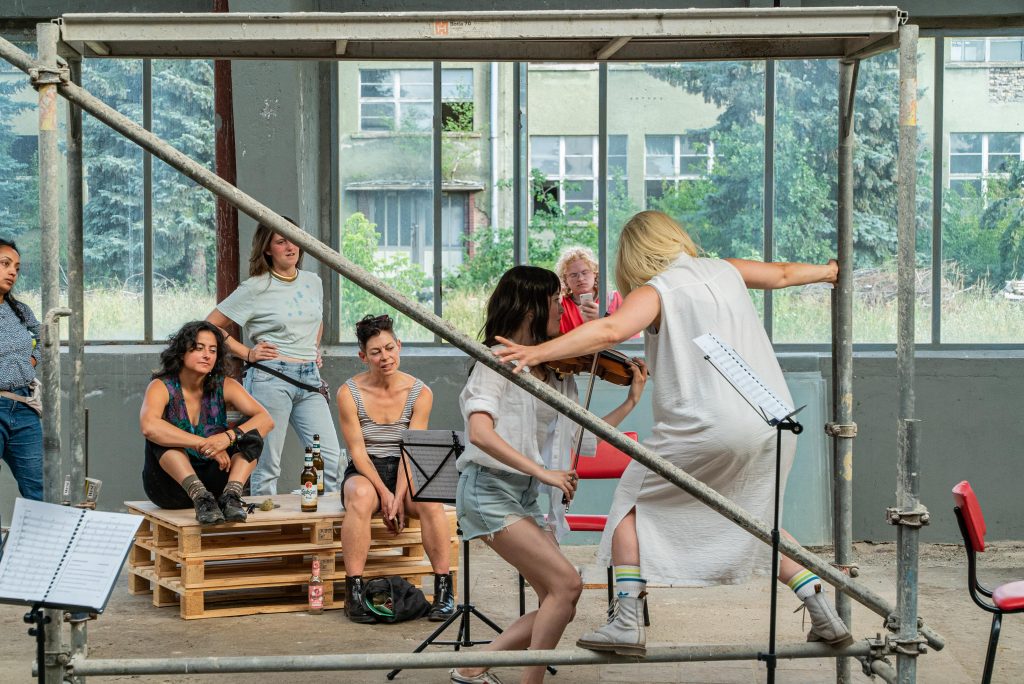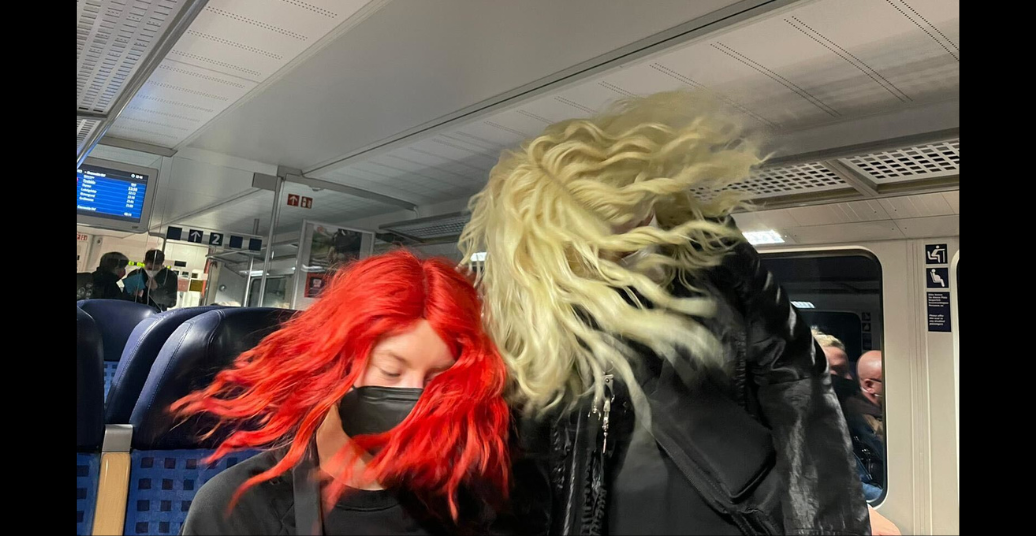I sit here with my finger poised on the keyboard, wondering how to begin writing about “H_SPACE_H” by Isabel Lewis and Sissel Tolaas with Solistenensemble Kaleidoskop and Ethan Braun. When words fail to come forth, I bury my face in the denim jeans I had worn the day of this durational performance (30 July 2022) near E-WERK Luckenwalde. An amalgamation of the many smells from the multi-site performative intervention still seem to linger in the fabric. My tongue is tickled by the memory of them, and questions tumble out.
If nothing were to be seen, smelt, or heard, is it a performance?
“H_SPACE_H” begins on the train ride from Berlin to Luckenwalde, a quiet city in Brandenburg. The carriage designated for the performance on the RE3 train is packed tight with passengers making the most of their nine-euro tickets. Some are unsuspecting chance travellers, and then there are those like me, who are expecting something to happen. I am alert with anticipation. What is going to happen? When exactly will it begin? Which of the people around us are performers? I sit, wedged on the flight of steps leading to the upper floor of the train. I hope, I am in the right place in the coach to ‘catch the action’.
When does an action become a performance?
Then I see her. She is walking decisively through the train carriage as though she has someone to meet. She holds one palm across her chest with her fingers stiff and pressed straight together. With just a quick glance, her posture could be mistaken for a common pose of self-protection, but there is an added communicative quality in the gesture. She stops suddenly and shakes out her shock of red hair. This quotidian action also appears uncanny — the pace of her head movement, the tension in her neck — making me suspect that this too was a conscious gesture. A performance. Then I smell it. I smell her. Her scent. In the confines of the train carriage, the smell traipses up to me and lingers, briefly. Then she walks on, and as she passes me, I breathe hungrily in to hold on to the scent a while longer. It is strong, striking — as if it wants to be taken notice of. She leaves my frame of visibility, disappearing into a thicket of shoulders.

Photo: “H_Space_H” by Isabel Lewis and Sissel Tolaas with Solistenensemble Kaleidoskop and Ethan Braun ©Maria Schneider
Does wearing perfume count as performance?
Minutes later, another performer with pale blond hair — I now clearly recognise it as a wig — walks past. She has one arm raised purposefully, not in a relaxed curve at the elbow, but rather as though she were airing out her armpits. She stands over the seated passengers, wafting another distinct scent over them. Her raised hand ends in a closed fist with the thumb sticking out slightly, like an antenna. Now and then, she shakes her hair, emanating more of the fragrance.
Can a performance end not with applause, but with a train announcement?
Before I know it, a third woman in a wig is standing close to me. I hear her hum a high pitched sound as if she were tuning her voice to something. I wait for a song to erupt but her faint notes are drowned out by the conversations around me. I stand up and follow the humming, wig-wearing being through the crowded train compartment and witness something of the culmination of this journey. The three wigged women are standing in different parts of the compartment and are engaged in a game of call and response. They interact by sending coded hand gestures and sounds to each other through glass doors and over and around the other passengers. The hand gestures made by one of the performers receives a response from the other wigged women in the form of different notes from the musical scale. In quick succession they utter “fa – la – so – do – la!” in varied pitches. At other times, the dynamic appears to be reversed, as though the movement gestures are responding to the notes. Just when I sense the beginning of “H_SPACE_H”, we reach Luckenwalde. Waiting to get off the train, I find myself standing right behind one of the performers. At the very last moment, I lean in to smell her hair.
How far can affect travel?
It is with surprise that I encounter a faint trace of the smell again at the E-WERK site. A contemporary arts centre in Luckenwalde, E-WERK is located in the city’s former power station that was shut down in 1989. After reopening as an arts institution, the space initiated sustainable energy production by burning wooden pallets sourced from local industries. This ‘Kunststrom’ (translated ‘art power’ in German) as it is called, is the reason for the characteristic smell in the chambers and basement. The programme notes inform us that the smell permeating the train journey was extracted from the site by artist Sissel Tolaas. This is just one of the ways in which “H_SPACE_H” proposes an evolving artistic intervention that samples elements from one space and references them in another, sometimes presenting them through an altered medium.
From the RE3 train, through the sparse streets of Luckenwalde, and then with a detour via E-WERK, we finally reach the former Mendelsohn Hutfabrik nearby, where “H_SPACE_H” surfaces again. The ambulatory approach continues in the vast halls of this space. Multiple sensory stimulations are brought from the confines of the train into the open hall, highlighting their individual and combined affective quality. The hum of the train travelling out of the city is now quieter, while the intensity of the smells, the movements, and the sounds produced by the performers are all turned up. Together they become modes of communication — sensing, listening, resonating, disagreeing, rebelling, and insisting. Yet still, something of the dynamic energy of the train journey from Berlin into Brandenburg continues to resonate here.
If I know the score and the choreography, is the magic of a performance lost?
“H_SPACE_H” puts all its cards on the table. The cues and scores for movement, sound, and smell are made explicit, written down on the sheet music placed on stands all along the space. The hall is divided into six zones each with a unique smell and with a sound genre that is allied to it. The performers — now seven of them — execute the musical notations with their voices and string instruments. They each wear a wig containing a singular chemical molecule that blends together to make a smell composition inspired by E-WERK and the Mendelsohn Hutfabrik. The audience moves with the performers or saunter independently through the different sound and smell spaces. It is the impulses of the all the bodies present in the space that design the performance — their curiosity to explore a new movement cue, my mind attempting to identify this unusual smell, his ears tuning into that distant tempo, their suddenly finding themselves amidst the performers, her choice to leave.

Photo: “H_Space_H” by Isabel Lewis and Sissel Tolaas with Solistenensemble Kaleidoskop and Ethan Braun ©Julia Grussing
Can a performance be informed by the basement of one building and the roof of another?
The neatly defined olfactory-sound zones soon dissolve, as sounds from other zones reverberate along the high ceilings and hat-shaped roof of the Mendelsohn Hutfabrik. Performers propose aural interventions and movement gestures to create a harmonious composition that continues the game of call and response, and which also sets forth disruption and resistance. Sitting in the space marked ‘A’, I am serenaded by the tremolo riffs from the violin and double bass of two performers sitting near me. My line of sight also allows me to watch the performer in the distant ‘S’ space, and notice it is she who is conducting the sounds around me with her subtle hand gestures. The hand gestures from the train ride come back to me, now with more significance. The loose fist signifies ‘do’ and the flat palm ‘so’. When the angle or placement of the gesture changes in relation to the body, there are variations in the sound too. As the performers around me stroke the strings with their bows, it sends a vibration that is visible along their bodies, and through their heads. It is this trembling of their heads and hair that sends another wave of the composition of their blended smells in my direction. Another performer runs past me strumming her fingers along the metal barricades in the space, disruptively noisily on a scale of ‘ti’. Seconds later, when her unique smell washes over me, I hear a moaning allegro from the direction of the space marked ‘H’.
Finally, that age-old question of what came first: the chicken or the egg? Movement or sound?
“H_SPACE_H” feels to me like an evolving artwork whose roots cannot easily be traced. The first intervention in April explored smell, which was then joined by movement in the second intervention choreographed by Isabel Lewis. In this iteration of the performance, sound was brought in as the third component, performed by Solistenensemble Kaleidoskop and composed by Ethan Braun. All elements now permeate one another without an apparent fixed hierarchy. It is sometimes the movement gestures that are interpreted to create the soundscape, at other times, the smell affects the sound, or the sound urges movement across thespace. This results in a work that moves organically through its subtle fragmented states, weaving fragility with tension. My personal experience of “H_SPACE_H” is of torn up pieces of verse in different languages, that reconfigure each time to make new and unique poetry.
If I tell you about an experience in words, is there anything left to experience?

Photo: “H_Space_H” by Isabel Lewis and Sissel Tolaas with Solistenensemble Kaleidoskop and Ethan Braun ©Julia Grussing
“H_SPACE_H” by Isabel Lewis and Sissel Tolaas with Solistenensemble Kaleidoskop and Ethan Braun was shown on 30 July 2022 at E-WERK Luckenwalde. The performance was part of the finnissage for POWER NIGHTS: Being Mothers, curated by Lucia Pietroiusti, Helen Turner, Katharina Worf and Adriana Tranca.




